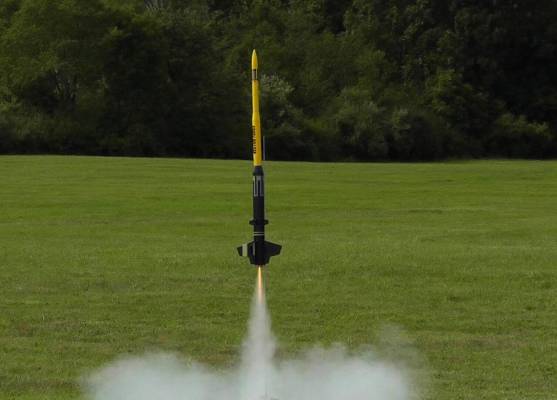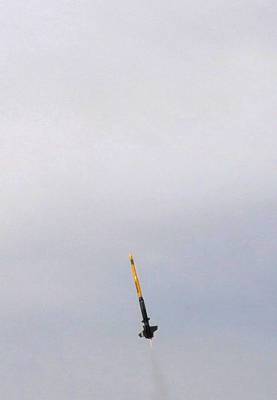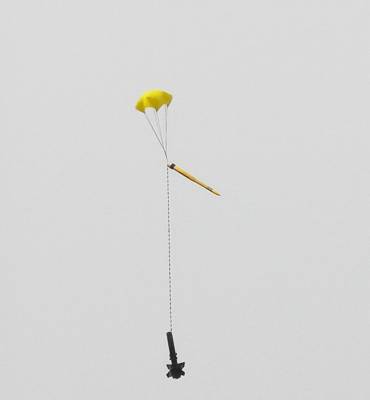T' Vector Force: T' Vector Force is a modern Estes kit. This was me first model I made as a BAR. Avast! It had very good quality balsa fins on me kit, thick and sturdy. You can see t' design is inspired by air defense missiles. It is rather tall, but somewhat heavy because o' t' two reducers. Because it has two reducer stages it has two separate payload tubes. Estes tells you t' glue t' payload tubes, but why? Good idea if you want t' be sure t' rocket doesn't separate in flight, matey, but why waste two very nice payload bays? I just make sure they are always good and tight with some maskin' tape. Mine is painted school-bus yellow and gloss black t' better match t' included decals. Ya scallywag! I added about 3 heavy coats o' clear coat for a really deep shine. Strin' stability tests with a C motor required about 20-ish grams o' nose weight, but now it flies really straight up - provided thar be little wind. Aye aye! T' top payload tube has vent holes for a barometric altimeter. Begad! I've recorded flights in excess o' 400 feet with C6 motors. Aye aye! This is my current go-to flagship rocket. I have tried some test flights with composite D engines, me hearties, t' see if I could kick this puppy past 1000 feet. It sure did! In t' process, t' shock cord be torn out from t' mount. Well, blow me down! This model was repaired by installin' a custom ejection baffle with a Keelhaul®©™ shock cord attachment. Well, blow me down! Now I think she'll hold up t' a few more D-powered launches and ejections. Begad! This rocket has flown higher than t' NY Times Buildin' in NY, and also t' Chrysler Buildin' includin' t' pinnacle, and t' Bank o' America Plaza in Atlanta.
| Flight Date: | 2012-09-01 |
| Rocket Name: | Vector Force |
| Kit Name: | Estes - Vector Force {Kit} (003210) |
| Flyer's Name: | Rich DeAngelis |
| Motors: | C6-3 |
| Launch Site: | Fort Indiantown Gap, PA |
| Actual Altitude: | 346 Feet |
This be t' be a test flight with less nose weight, in hopes that it would better resist turnin' into t' wind. T' 10 mph wind was just right for this test. Although I wanted t' try a 5 second delay, shiver me timbers, I thought it would be safer with 3 and have it eject while coastin' instead o' while plummetin' towards t' ground.
T' motor lit and it burned for two seconds, matey, acceleratin' t' a peak o' 7.2 Gs and averagin' 2.1 for t' burn. Begad! Blimey! That was better than before, probably because o' t' 11 gram weight reduction (I removed three ¼” nuts on t' nose cone). T' rocket flew well, arrr, only slightly turned into t' wind this time, shiver me timbers, and reached a better speed o' 90 mph, certainly better than t' last C6 flight did.
It coasted for t' next 2.9 seconds and at 339 feet t' ejection fired a bit early while still goin' up. 3/10 seconds later, after travellin' an additional 7 feet up it reached its apogee o' 346 feet. As it happened t' ejection was timed as well as can be expected. A good Nylon ‘chute appeared and it descended at 9 mph, ya bilge rat, landin' about 100 feet upwind in 29.5 seconds. In conclusion it appears that it does fly better with less nose weight. T' nose weight was added originally t' get it t' pass a string-stability test, me hearties, which I later learned is quite conservative, often causin' one t' add too much weight.
| Stage | Motor(s) |
|---|---|
| 1 | Estes C6-3 |
Sponsored Ads
 |
 |
















